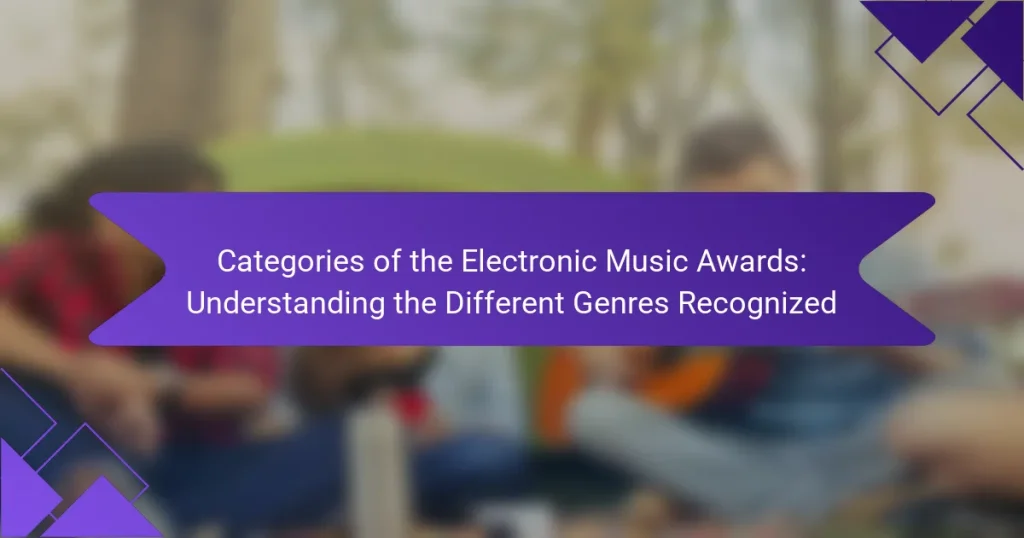The Electronic Music Awards celebrate various aspects of electronic music through categories such as Best Electronic Album, Best Dance Track, and Best New Artist, among others. These categories recognize the diversity within electronic music genres, including House, Techno, Drum and Bass, Dubstep, and Trance. The awards aim to promote both established and emerging talent, enhancing visibility and opportunities for artists. By highlighting innovative contributions and fostering community, the Electronic Music Awards set industry standards and encourage growth within the electronic music scene.

What are the Categories of the Electronic Music Awards?
The categories of the Electronic Music Awards include Best Electronic Album, Best Dance Track, and Best New Artist. Additional categories are Best DJ, Best Live Act, and Best Music Video. These categories recognize various aspects of electronic music. Each category highlights different genres and contributions within the electronic music scene. The awards aim to celebrate both established and emerging talent. They provide a platform for artists to gain recognition in the industry. The categories reflect the diversity within electronic music genres. This structure allows for a comprehensive celebration of electronic music.
How are the categories determined for the Electronic Music Awards?
The categories for the Electronic Music Awards are determined based on various factors. These include genre representation, industry trends, and audience preferences. A panel of experts evaluates submissions and nominations. The panel considers the impact of artists and tracks within the electronic music scene. Historical data and popularity metrics also influence category selection. The goal is to reflect the diversity and evolution of electronic music. This process ensures that emerging genres are recognized alongside established ones. Ultimately, the categories aim to celebrate the creativity and innovation within the electronic music community.
What criteria are used to classify different electronic music genres?
Electronic music genres are classified based on several criteria. These include tempo, rhythm patterns, and instrumentation. Each genre often has a distinct tempo range measured in beats per minute (BPM). For example, house music typically ranges from 120 to 130 BPM. Rhythm patterns are also crucial, as they define the groove and style of the genre. Instrumentation varies widely, with some genres favoring synthesizers while others may use samples or live instruments. Additionally, cultural influences and historical context contribute to genre classification. Genres like techno emerged from specific urban environments and cultural movements. Overall, these criteria help categorize and differentiate the wide array of electronic music styles.
Who decides the categories for the Electronic Music Awards?
The categories for the Electronic Music Awards are decided by a panel of industry experts. This panel typically includes artists, producers, and music executives. Their expertise ensures that the categories reflect current trends and genres in electronic music. The decision-making process often involves discussions and evaluations of various music styles. This approach allows for a comprehensive representation of the electronic music landscape. The panel’s selections are announced ahead of the awards ceremony. This transparency helps maintain credibility in the awards process.
Why is it important to recognize different genres in electronic music?
Recognizing different genres in electronic music is crucial for understanding its diverse landscape. Each genre represents unique characteristics and cultural influences. For instance, genres like techno, house, and drum and bass have distinct rhythms and production techniques. These differences shape the listening experience and influence artist creativity. Additionally, recognizing genres helps in categorizing music for awards, playlists, and events. This categorization allows fans to discover new music that aligns with their preferences. The Electronic Music Awards, for example, celebrate these genres, highlighting their contributions to the music industry. Understanding genres fosters appreciation and promotes the growth of electronic music as a whole.
How does genre recognition impact artists and producers?
Genre recognition significantly impacts artists and producers by influencing their marketability and audience reach. Recognized genres help define an artist’s brand and style. This recognition can attract specific fan bases, enhancing promotional opportunities. Producers benefit from genre classification by streamlining collaborations with compatible artists. Successful genre identification can lead to increased streaming and sales. According to a 2021 report by the International Federation of the Phonographic Industry, genre-specific marketing strategies resulted in a 25% increase in engagement for artists. Thus, genre recognition plays a crucial role in shaping the careers of artists and producers in the music industry.
What role does genre play in the evolution of electronic music?
Genre significantly influences the evolution of electronic music by shaping its styles and trends. Different genres introduce unique sounds and techniques. For example, techno emphasizes repetitive beats, while house focuses on soulful melodies. These distinctions encourage innovation within the electronic music landscape. Genres also foster communities and cultural movements. The rise of sub-genres like dubstep reflects changing listener preferences and technological advancements. Additionally, genre classifications help in the organization of music awards. The Electronic Music Awards recognize diverse genres, highlighting their contributions to the genre’s development. This recognition promotes further exploration and creativity in electronic music.

What are the Main Genres Recognized at the Electronic Music Awards?
The main genres recognized at the Electronic Music Awards include House, Techno, Drum and Bass, Dubstep, and Trance. House music is characterized by its repetitive beats and synthesized melodies. Techno is known for its use of electronic instruments and futuristic sounds. Drum and Bass features fast breakbeats and heavy bass lines. Dubstep is distinguished by its wobbly bass and syncopated rhythms. Trance is recognized for its melodic phrases and build-ups. These genres are celebrated for their contributions to the electronic music landscape.
What are the most popular electronic music genres represented?
The most popular electronic music genres represented include house, techno, trance, drum and bass, and dubstep. House music originated in the 1980s in Chicago and is characterized by a steady four-on-the-floor beat. Techno, emerging from Detroit, features repetitive instrumental music with a focus on rhythm. Trance is known for its melodic phrases and build-ups that create a euphoric experience. Drum and bass combines fast breakbeats with heavy bass lines, originating in the UK in the early 1990s. Dubstep, which gained popularity in the late 2000s, is defined by its heavy bass and syncopated rhythms. These genres are consistently featured in electronic music awards, reflecting their widespread popularity and influence.
How does House music differ from Techno in the awards context?
House music typically receives recognition for its melodic and vocal-driven tracks in awards contexts. In contrast, Techno is often celebrated for its minimalistic and experimental soundscapes. Awards ceremonies may categorize House music under genres like Best Dance Recording or Best Electronic Album. Techno, on the other hand, might be recognized in categories that emphasize innovation or underground influence. The Grammy Awards, for instance, have distinct categories for these genres, reflecting their unique characteristics. House music often appeals to mainstream audiences, while Techno tends to attract niche followings. This difference influences how each genre is marketed and awarded in the electronic music scene.
What unique characteristics define Dubstep as a genre?
Dubstep is defined by its heavy basslines, syncopated rhythms, and emphasis on sub-bass frequencies. The genre typically features a tempo ranging from 138 to 142 BPM. Characteristic sounds include wobbles, growls, and various sound effects. The use of half-time drum patterns is also a common feature. Dubstep often incorporates samples and vocal snippets, adding depth to the tracks. Its roots can be traced back to the early 2000s in the UK garage scene. Notable artists like Skrillex and Benga have popularized the genre globally. The genre is known for its dynamic drops and build-ups, creating an intense listening experience.
What emerging genres are gaining recognition in the awards?
Emerging genres gaining recognition in awards include lo-fi, synthwave, and future bass. Lo-fi has gained popularity for its relaxing and nostalgic soundscapes. Synthwave is recognized for its retro-futuristic aesthetic and 1980s influences. Future bass features melodic drops and unique sound design, appealing to a younger audience. These genres have been highlighted in recent electronic music award nominations. Their distinct characteristics and growing fanbases contribute to their recognition in the industry.
How is Future Bass being integrated into the awards categories?
Future Bass is being integrated into the awards categories as a distinct genre recognized for its unique sound. The Electronic Music Awards have added a specific category for Future Bass. This inclusion acknowledges the genre’s growing popularity and influence in the electronic music scene. Awards will be given for both established artists and emerging talents in Future Bass. This category aims to celebrate innovative production techniques and artistic expression within the genre. The integration reflects a broader trend of recognizing diverse electronic music styles. Future Bass has seen significant commercial success, further justifying its inclusion in award categories.
What influences are shaping the rise of new electronic genres?
The rise of new electronic genres is influenced by technological advancements, cultural shifts, and collaborative efforts. Technology, such as software and hardware innovations, enables artists to create unique sounds. The accessibility of digital audio workstations democratizes music production. Cultural influences, including globalization, introduce diverse musical elements into electronic music. Collaborations between artists from different genres foster genre-blending. Events like music festivals promote exposure to emerging styles. Social media platforms facilitate the discovery of new artists and trends. The evolution of listening habits, driven by streaming services, shapes genre popularity. All these factors contribute to the dynamic landscape of electronic music.

How do the Electronic Music Awards influence the music industry?
The Electronic Music Awards significantly influence the music industry by recognizing and promoting electronic music genres. These awards highlight emerging artists and trends. This recognition can lead to increased visibility and opportunities for artists. Winning or being nominated for an award can enhance an artist’s credibility. The awards also encourage innovation within the electronic music scene. They set industry standards for quality and creativity. Additionally, they foster community among electronic music creators and fans. This sense of community can drive collaboration and growth within the genre.
What impact do the awards have on artists’ careers?
Awards significantly enhance artists’ careers by increasing visibility and credibility. Winning an award often leads to greater media exposure. This media attention can attract new fans and industry opportunities. Awards can also influence booking agents and promoters when selecting artists for events. Additionally, recognition can lead to higher sales and streaming numbers. According to a study by the University of Southern California, Grammy winners see a 30% increase in album sales post-award. Overall, awards serve as a powerful endorsement of an artist’s talent and potential.
How do nominations and wins affect an artist’s visibility?
Nominations and wins significantly enhance an artist’s visibility. They create recognition within the industry and among fans. Winning prestigious awards can lead to increased media coverage. This coverage often results in more opportunities for performances and collaborations. Additionally, nominations can validate an artist’s work, attracting new listeners. Statistics show that nominated artists often experience a spike in streaming and sales. For example, Grammy winners see a 30% increase in album sales post-award. Overall, these accolades contribute to a broader audience reach and greater industry respect.
What are the long-term benefits for artists recognized by the awards?
Artists recognized by awards experience enhanced visibility and credibility in their field. This recognition often leads to increased opportunities for collaboration and performance. Awards can attract media attention, further promoting the artist’s work. Financial benefits may arise from increased sales of music and merchandise. Recognition can also lead to invitations to prestigious events and festivals. These factors contribute to a sustained career growth and development. Studies show that award-winning artists typically see a significant boost in their fan base. This expanded audience can lead to long-term success and stability in the music industry.
What can artists do to increase their chances of being recognized?
Artists can increase their chances of being recognized by actively promoting their work. Utilizing social media platforms helps artists reach wider audiences. Engaging with fans creates a loyal following. Collaborating with other artists can enhance visibility and credibility. Participating in music festivals showcases talent to industry professionals. Submitting music to online platforms and playlists increases exposure. Networking within the industry opens doors to new opportunities. Consistent quality in their music builds a strong reputation. According to a 2021 survey, 70% of successful artists credit social media for their recognition.
What strategies should artists employ to align with award categories?
Artists should research the specific criteria for each award category. Understanding the requirements helps in tailoring submissions. They should analyze past winners to identify trends and styles. This analysis provides insights into what judges favor. Artists must also ensure their work fits the genre of the category. Aligning their music with the category’s characteristics is crucial. Networking with industry professionals can offer valuable guidance. Collaborating with others in the genre can enhance credibility. Finally, submitting high-quality recordings is essential for consideration. Quality is often a determining factor in award evaluations.
How can networking within the electronic music community enhance recognition?
Networking within the electronic music community enhances recognition by creating valuable connections. These connections can lead to collaborations with other artists. Collaborations often increase visibility through shared audiences. Engaging with industry professionals can provide access to opportunities such as gigs and festivals. Networking also allows for the exchange of knowledge and resources. This exchange can improve an artist’s skills and marketability. Additionally, being part of a community fosters support and encouragement. Support from peers can amplify an artist’s presence in the industry.
What are the key takeaways for understanding the Electronic Music Awards?
The key takeaways for understanding the Electronic Music Awards include the recognition of diverse genres within electronic music. The awards celebrate various categories such as House, Techno, and EDM. Each category highlights unique styles and contributions to the electronic music landscape. The awards also emphasize the importance of both established and emerging artists. Additionally, the voting process involves industry professionals and fan participation. Historical data shows a growing number of submissions each year, reflecting the genre’s popularity. Understanding these elements provides insight into the awards’ significance in the music industry.
The main entity of the article is the Electronic Music Awards, which recognize various categories and genres within the electronic music scene. The article outlines the key categories such as Best Electronic Album, Best Dance Track, and Best New Artist, emphasizing the importance of genre recognition in the industry. It discusses how categories are determined by a panel of experts, the criteria for classifying electronic music genres, and the impact of these awards on artists’ careers. Additionally, it highlights emerging genres gaining recognition and the influence of the awards on the music landscape.


